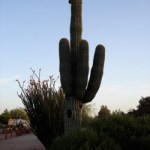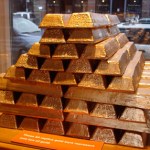
One of the newfangled ideas that's popped up in education in the past few years has been notion that more interactive methods of teaching will lead to better results.
There's an appealing logic to this notion.
Figure 1. A traditional lecture may not be the ideal way to transfer information.
Technorati Tags: education, active learning, clickers
To quote Eric Mazur (1) quoting D. Huff (2):
I once heard someone describe the lecture method as a process whereby the lecture notes of the instructor get transferred to the notebooks of students without passing through the brains of…
Since I'm an adjunct faculty member at a couple of community colleges, I'm able to delete most of my e-mail with barely a glance.
But this one made my jaw drop!
Dear Educators:
Alliance Library System and LearningTimes are pleased to announce an
exciting conference featuring science and virtual worlds. On January
30th we are "Stepping Into Science" and taking the day to explore the possibilities of using virtual worlds to learn about and teach science.
The conference will be taking place entirely in Second Life and will
feature a keynote and panel discussion as well as small breakout…
The 2009 Summer Research Experience for Undergraduates in Environmental Microbiology at UNLV is now accepting applications. This NSF supported program provides undergraduates with an opportunity to perform independent research under the guidance of a faculty mentor.
Students will collaborate with faculty mentors in developing and carrying out hypothesis-based projects on microorganisms from diverse habitats such as hot springs, the deep terrestrial subsurface, hypersaline lakes, arid soils, and ephemeral water sources. Students may also choose to explore the mechanisms of magnetotaxis,…
On a quiet corner in Seattle's Pioneer Square, in the former Cadillac Hotel, sits the Klondike Gold Rush national park. Inside the park, are photographs and exhibits to help visitors learn about the Klondike gold rush of 1987 and the role Seattle played in outfitting the stampeders.
Figure 1. One ton of gold.
I've heard stories about the gold rush for many years and even visited the museum in Fairbanks. Still, there were new things to learn and today's current events give perspective to the happenings of 1897. Before visiting the park, I didn't know much anything about the panic of 1893…
The HudsonAlpha Institute for Biotechnology is a non-profit organization that opened it's doors in April, 2008. One of the great things about this institute is it's commitment to sharing biotech knowledge with the surrounding community.
For the general public, HudsonAlpha has a ongoing written series on biology topics called Biotech 101. Teachers will probably find this useful too. There's a great description of Copy Number Variation written by Dr. Neil Lamb, their director of educational outreach. Some of the other pieces discuss Microarrays, Epigenetics, and RNAi.
School programs…
AIDS, to me, is such a scary horrible disease that it seems that all of us would naturally support a cure and work together stop it from spreading. I even forced my family to watch a movie on AIDS over the holidays. (And the Band Played On, based on a book with same title by Randy Shilts, who died of AIDS in 1994).
That's why I was astounded to read last night, at the Physicians for Human Rights (PHR) news site, that the Iranian government has put two doctors in prison - doctors who specialize in treating AIDS patients. The PHR, if you're wondering, is well known for supporting human…
My husband brought this fantastic book home from the ASHG* that I think many of you will find interesting.
The book is: Making the Right Moves A Practical Guide to Scientific Management for Postdocs and New Faculty, published in 2006 by the Burroughs Wellcome Fund and the Howard Hughes Medical Institute.
You can download the book for free at the HHMI site and there's even a video of Tom Cech.
In fact, this book has such great information, that if it weren't for the interesting discussions in the comment section, I truly think this book would put Drug Monkey Comrade PhysioProf, and Isis…
Teachertube looks and works much like YouTube, but you're much less likely to run across videos that Not Safe For the Classroom.
All of these videos are made by students and teachers. According to the Dallas News, there are 54,000 videos on the site already and 800,00 visitors every day.
I especially enjoyed watching Abbot and Costello doing math problems.
Last fall, this blog got nominated for the 2008 Edublog awards, in the Best resource sharing category.
I was a bit distracted in December so this information came and passed without any acknowledgement. Now, I would like to thank whoever nominated Discovering Biology in a Digital World.
I'm especially thankful because I got to learn about all the wonderful blogs listed at the Edublog award web site.
Sigh. So many blogs, so little time.
Technorati Tags: 2008 Edublog awards
I don't know if any DIY biologists are looking for projects, but I think engineering yeast with a gene to detect heavy metals might be a good DIY biology project and I have some ideas for how to do this.
What are the advantages of using yeast and working on this kind of problem?
This could have a socially beneficial result. Contamination of soils, water, and even toys with heavy metals like lead, arsenic, and others, is a growing problem. If DIY biologists could make a cheap test, it could be helpful for a large number of people.
Yeast, at least the ones I'm thinking about, Saccharomyces…
My garden at home is looking a bit bleak after all the snow, Mendel's Garden is blooming wonderfully at Jeremy Cherfas' blog Another Blasted Weblog.
Jeremy has prepared a nice collection of perennial favorites. I especially like the story about pea breeding and, if you view the post, there are several interesting pictures of peas. These peas are far more diverse than the kind you'd normally see in a genetics text. Not all peas are shrunken or waxy.
genetics, Mendel's garden, blog carnival
Science education faculty don't get no respect
At least that's a strong conclusion from a paper in the December 19th issue of Science (1). According to the article almost 40% of the 59 science education specialists, surveyed in the California University system, were "seriously considering leaving" their current jobs and some (20%) were considering leaving the field entirely.
Why?
Figure 1. Are science education specialists the Rodney Dangerfields of academics?
Before we continue, some more background information is in order. Who are these science education specialists and why do we have…
Some of the things that are attracting people to DIY biology are:
the idea of doing science with others for fun
the possibility of doing something that might be beneficial to society
being part of larger movement
All of those notions appeal to me and since I've been involved with biotech for many years, I have lots of project ideas. After thinking about the yogurt and melamine detection project, I started to wonder if a DIY project could even have a bigger impact, and say, develop a cheap test for heavy metals like arsenic or lead.
In Seattle, it costs between $30 and $50 to test water…
My oldest daughter's favorite sweatshirt is one from the Seattle Children's Theatre Drama School, with the motto, "What's your motivation?"
I was reminded of motivation the other day, as I talked about projects with the DIY biology group. It's pretty clear that you can't pick a project without knowing whether you're motivated by the discovery or the application.
Many of the people I've known in academia, either researchers or science educators, are motivated by the prospect of discovery. They either want to discover something new or help their students make discoveries. Inquiry-based…
This afternoon, I attended the first meeting of a DIY biology group in Seattle, after a kind invitation from one of the founders.
DIY, for those of you new to the acronym, stands for "Do It Yourself."
But, you say, there are lots of people who do biology on their own. Some people keep pets. Some have children. Others raise tropical fish, go bird watching, or mushroom hunting. Some people even make yogurt or cheese, or brew beer, or make wine. What makes DIY biology so different?
This isn't your grandfather's home brew
Well, lets say for now that it's a little…
The New York Times had a great article a couple of days ago on the need for personalized medicine to become more than a catchy phrase.
As we're learning more about the interaction between genes and drug metabolism, we're also learning that large numbers of people are either taking the wrong drug or taking drugs that won't work.
tags: personal genomics,
pharmacogenomics
Researchers have known for some time that genetic variants determine how well drugs work. Some versions of a gene cause a drug to be metabolized faster, some slower, and when combined, at an intermediate rate. In the…
Mosquito-borne diseases, like Dengue and Malaria, are serious problems in many parts of the world. While some people are working on treatments for mosquito-carried disease, others are looking at ways to treat the mosquitoes.
Figure 1. Image of Aedes aegypti from the Public Health Library
tags: tropical disease, yellow fever, dengue, insect control,
malaria
Controlling insect activities by messing with their genomes isn't a new idea. In many parts of the world, screwworms are controlled by damaging their genomes on a large scale by treating the flies with X-rays and releasing the…
I made this video last night with a Flip Cam Mino. There are some kind of wild trippy effects. Sometimes it even looks like there's popcorn shooting out the top of the space needle. It was sure fun!
Happy New Year everyone!
technorati tags: fireworks, Seattle, New Year's Eve, Space Needle
The other day, one of my commenters stated that "a well-informed sixth-grader should be able to distinguish between MRSA and E. coli".
Here's a nutrient agar plate with some of the bacteria that we isolated from a local creek last fall. We identified our bacteria by sequencing the 16S ribosomal DNA, but for various reasons, that I won't go into here, we don't know which sequences belong to which colonies.
Figure 1. Bacteria isolated from a local creek.
I guess we need some well-informed sixth graders. ;-)
Cloning the gene for green fluorescent protein is fun. Lots of fun. Cloners have put the GFP gene into rabbits, plants, cats, fish, and worms, and made mutants that code for proteins in every color of the fluorescent rainbow. Teachers like GFP so much that every year, high school students throughout the U.S. clone GFP in biology class.
Now, some people, who call themselves DIY biologists, have started cloning GFP for fun in their kitchens. Other people find this alarming.
From Yahoo news:
Jim Thomas of ETC Group, a biotechnology watchdog organization, warned that synthetic organisms…


